Bouches-du-Rhône
Bouches-du-Rhône (French pronunciation: [buʃ dy ʁon], locally [buʃə dy ʁonə]; Occitan: Bocas de Ròse, pronounced [ˈbukɔz de ˈʁɔze]; literally "Mouths of the Rhône") is a department in Southern France named after the mouth of the river Rhône. It is the most populous department of the Provence-Alpes-Côte d'Azur region with 2,019,717 inhabitants in 2016; it has an area of 5,087 km2 (1,964 sq mi). Its INSEE and postal code is 13. Marseille is Bouches-du-Rhône's largest city and prefecture.
Bouches-du-Rhône | |
|---|---|
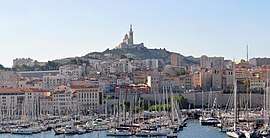    From top down, left to right: Marseille, the department's prefecture, Les Baux-de-Provence, one of the most beautiful villages in France, Cassis on the Mediterranean coast and the Arles Amphitheatre | |
 Flag  Coat of arms | |
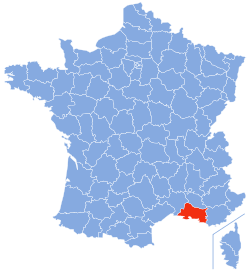 Location of Bouches-du-Rhône in France | |
| Coordinates: 43°30′N 5°5′E | |
| Country | France |
| Region | Provence-Alpes-Côte d'Azur |
| Prefecture | Marseille |
| Subprefectures | Aix-en-Provence Arles Istres |
| Government | |
| • President of the Departmental Council | Martine Vassal (LR) |
| Area | |
| • Total | 5,087 km2 (1,964 sq mi) |
| Population (2016) | |
| • Total | 2,019,717 |
| • Rank | 3rd |
| • Density | 400/km2 (1,000/sq mi) |
| Time zone | UTC+1 (CET) |
| • Summer (DST) | UTC+2 (CEST) |
| Department number | 13 |
| Arrondissements | 4 |
| Cantons | 29 |
| Communes | 119 |
| ^1 French Land Register data, which exclude estuaries, and lakes, ponds, and glaciers larger than 1 km². | |
History
The history of the area is closely linked to that of Provence. Marseille has been an important harbour since before Julius Caesar's conquest of Gaul. The Roman presence left numerous monuments across the department. Notable people born in the area include Romantic painter Camille Roqueplan and his brother, journalist and theatre director Nestor Roqueplan.
Bouches-du-Rhône is one of the original 83 departments created during the French Revolution on 4 March 1790. It was created from the western part of the former province of Provence and the principalities of Orange, Martigues and Lambesc. It lost part of its territory in 1793, including Orange and Apt, when the Vaucluse department was created.
Following its creation, the department was immediately strongly and actively supportive of the French Revolution, containing 90 "Jacobin Clubs" by 1794.[1] It was also noteworthy that more than 50% of the priests in the department accepted the Civil Constitution of the Clergy which in effect subordinated the church to the government.[2] During the ascendancy of the French Communist Party in the twentieth century election results indicated that support for left-wing politics remained relatively strong in the department, and especially in the northern suburbs of Marseille.
Geography
Natural regions
The department is part of the current region of Provence-Alpes-Côte d'Azur. It is surrounded by the departments of Gard on the west, Vaucluse on the north, and Var on the east, and by the Mediterranean Sea on the south. The Rhône river delta forms a vast swampy wetlands area called the Camargue in the southwestern part of the department.
Bouches-du-Rhône is bordered by the Rhône to the west and the Durance to the north. The Rhône divides into the Grand Rhône and Petit Rhône south of Arles; the area between forms the Camargue, a large wetland. The principal mountains of the department are the Sainte-Baume massif (1,042 metres – 3,418 feet), Mont Sainte-Victoire (1,011 metres – 3,316 feet), the Garlaban massif and Alpilles massif.
Seismic activity

The department of Bouches-du-Rhône is also known for its seismic activity: the zone II ("average seismic activity") townships of Lambesc Peyrolles-en-Provence and Salon-de-Provence are the most exposed.
Areas Ib ("low seismic activity") including the cantons of Aix-en-Provence, Trets Eyguières, Orgon, Berre-Pond, Istres, Istres-North and South, and Ia areas ("very low seismic activity") including the other cantons in the district of Aix-en-Provence, Arles-East, Châteaurenard, Saint-Rémy-de-Provence, Marignane, Martigues-East and Roquevaire-West, are least exposed. Zone 0 ("negligible seismic activity") includes the rest of the department.
Climate
The department has a Mediterranean climate, with contrasting temperatures within a range of 15 degrees. Precipitation is irregular, with only 65 days per year where rain falls in excess of 1 mm. However it falls in sudden downpours, with an average of 500–700 millimetres (20–28 inches) annually. This mainly happens in the spring and autumn; summer is very hot, winter mild. Violent winds are common, especially the famed mistral, which blows 100 days per year with a maximum of 100 km/h (62 mph). The coast is drier, especially along the Côte Bleue, the Calanques and the bay of La Ciotat, which include some of the driest areas in France, with only 450 mm (18 in) of rain per year. Higher areas receive more precipitation and lower temperatures. The Arc region in the interior is much colder than other areas, with heavy frosts in winter.
Demographics
| Year | Pop. | ±% p.a. |
|---|---|---|
| 1801 | 285,012 | — |
| 1806 | 292,903 | +0.55% |
| 1821 | 313,614 | +0.46% |
| 1831 | 359,473 | +1.37% |
| 1841 | 375,003 | +0.42% |
| 1851 | 428,989 | +1.35% |
| 1861 | 507,112 | +1.69% |
| 1872 | 554,911 | +0.82% |
| 1881 | 589,028 | +0.67% |
| 1891 | 630,622 | +0.68% |
| 1901 | 734,347 | +1.53% |
| 1911 | 805,755 | +0.93% |
| 1921 | 841,996 | +0.44% |
| 1931 | 1,101,672 | +2.72% |
| 1936 | 1,224,802 | +2.14% |
| 1946 | 971,935 | −2.29% |
| 1954 | 1,048,762 | +0.96% |
| 1962 | 1,248,555 | +2.20% |
| 1968 | 1,470,271 | +2.76% |
| 1975 | 1,632,974 | +1.51% |
| 1982 | 1,724,199 | +0.78% |
| 1990 | 1,759,371 | +0.25% |
| 1999 | 1,835,719 | +0.47% |
| 2016 | 2,019,717 | +0.56% |
| source:[3] | ||
The department's prefecture and largest city, Marseille, contains a major industrial harbour and serves as France's largest commercial port. The Bouches-du-Rhône department is largely urban, with 28 towns having a population of more than 10,000 as of 2008.
More than 20,000 inhabitants
- Marseille, population 853,000 (2 million in the urban area that includes the following cities) is the departmental and regional capital (prefecture)
- Aix-en-Provence, population 142,743, subprefecture, a university town and seat of the regional Court of Appeals
- Arles, population 52,729, sous-préfecture and site of an ancient Roman city
- Martigues, population 46,471, the leading city for the European petrochemical industry
- Aubagne, population 46,093, birthplace of Provençal author Marcel Pagnol
- Istres, population 42,603, sous-préfecture and home to a military airbase
- Salon-de-Provence, population 41,411, the home city of 16th-century soothsayer Nostradamus
- Vitrolles, population 36,610
- Marignane, population 33,909, site of Marseille Provence Airport
- La Ciotat, population 33,790
- Miramas, population 25,632, regional railway hub
- Gardanne, population 21,121
- Les Pennes-Mirabeau, population 20,187
Less than 20,000 inhabitants
- Allauch, population 18,728
- Port-de-Bouc, population 17,207
- Fos-sur-Mer, population 15,448
- Châteaurenard, population 14,817
- Berre-l'Étang, population 13,881
- Bouc-Bel-Air, population 13,437
- Tarascon, population 13,340
- Rognac, population 12,195
- Auriol, population 11,969
- Châteauneuf-les-Martigues, population 11,564
- Plan-de-Cuques, population 11,096
- Saint-Martin-de-Crau, population 10,979
- Saint-Rémy-de-Provence, population 10,662
- Septèmes-les-Vallons, population 10,481
- Trets, population 10,239
- Arles
- Martigues
 Istres
Istres Salon-de-Provence
Salon-de-Provence.jpg) La Ciotat
La Ciotat
Politics
History

Since the Bouches-du-Rhône department is one of the most populous and diverse departments, it has long been the scene of particularly fierce political battles. The development of the Marseille-Fos Port, the relationship maintained between France and its colonial empire, the industry around coal mining in Provence, and significant immigration, especially coming from Italy, from the end the nineteenth century and during the period between the two wars are all factors that led to the emergence of a large and militant working class. From the late nineteenth century, the socialist movement gained influence, such as by in 1881 by the election of the first socialist member of France, Clovis Hugues. Rural areas, and particularly in the region of Aix have tended to favor the influence of right-wing parties, including monarchists and Catholics at the beginning of the French Third Republic. The interwar period and the time of the Popular Front marked the beginning of the dominance of the left in the department, first with the election of the SFIO.
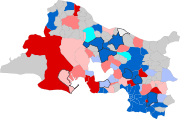
After the Second World War, the Marseillais right, linked to the underworld and who collaborated with the German occupation, was widely discredited. The left largely dominated the Liberation and Marseille even saw the election in 1945, of a Communist Mayor, Jean Cristofol. In 1947 the SFIO led an alliance with right and centre parties against the Communists, resulting in the election of Gaston Defferre as Mayor of Marseille. The dominance of socialism was, however, challenged by deindustrialization. The conservative success in 1995 by Jean-Claude Gaudin in Marseille is a symbol of widespread political shifts while even the communists bastions of La Ciotat and Port-Saint-Louis-du-Rhône voted for the right. The 1990s saw the rise of the National Front, including its victories in the municipal elections of Marignane and Vitrolles. The President of the Departmental Council is Martine Vassal of The Republicans party since 2015, after former Socialist President Jean-Noël Guérini was voted out of office and faces corruption charges.
Members of the National Assembly
Bouches-du-Rhône elected the following members of the National Assembly during the 2017 legislative election:
Departmental Council of Bouches-du-Rhône
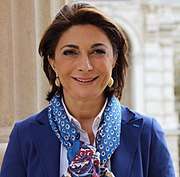
Below is a list of seats won by the department's different parties after the 2015 departmental elections.
| Party | Seats in the Departmental Council | |
|---|---|---|
| • | The Republicans (LR) | 25 |
| Socialist Party (PS) | 15 | |
| • | Union of Democrats and Independents (UDI) | 7 |
| French Communist Party (PCF) | 5 | |
| Europe Ecology – The Greens (EELV) | 2 | |
| La Force du 13 | 2 | |
| National Front (FN) and France Arise (DLF) | 2 | |
Culture
The department is well represented in French art. Paul Cézanne painted numerous representations of the Mont Sainte-Victoire. Vincent van Gogh spent two years in Arles, painting many scenes in the area. The department's main museums include the Museum of European and Mediterranean Civilisations, the Musée de la Faïence de Marseille and the Marseille History Museum.
Tourism
Main sights
Major sites of tourism include:
- The cities of Marseille and Aix-en-Provence
- Roman and Romanesque monuments of Arles
- The Camargue and the town of Saintes-Maries-de-la-Mer
- Alphonse Daudet's windmill in Fontvieille
- Les Baux-de-Provence, medieval village
- Saint-Rémy-de-Provence and the ruins of the Roman city of Glanum
- Tarascon, medieval castle and church
- Salon-de-Provence, city of Nostradamus and one of the biggest citadels in Provence: Château de l'Empéri
- The Calanque de Sormiou, Marseille
Natural landmarks
Rivers include:
- The Rhône, which forms the border with the Gard department
- The Durance, which forms the border with the Vaucluse department
- The Arc
- The Huveaune
Lakes include:
- Étang de Berre
- Étang de Vaccarès, in the Camargue
Mountains include:
- Alpilles mountain range
- Calanques between Marseille and La Ciotat
- Corniche des Crêtes
- Garlaban
- Mont Puget
- Montagne Sainte-Victoire
- Sainte-Baume massif
See also
Sources
- Albert Ceccarelli, La Révolution à l’Isle sur la Sorgue et en Vaucluse, Éditions Scriba, 1989, 2-86736-018-8, p. 27.
- Albert Ceccarelli, La Révolution..., p. 30.
- Site sur la Population et les Limites Administratives de la France
- http://www.assemblee-nationale.fr/
External links
| Wikimedia Commons has media related to Bouches-du-Rhône. |
| Wikisource has the text of the 1911 Encyclopædia Britannica article Bouches-du-Rhône. |
- (in French) Prefecture website
- (in French) General Council website
- (in French) Website from the Camargue

.jpg)

.jpg)
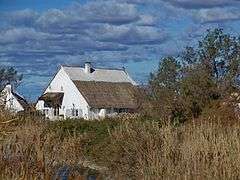
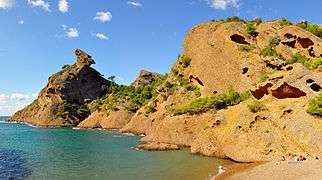


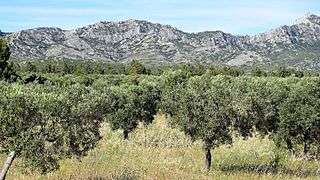
.jpg)
